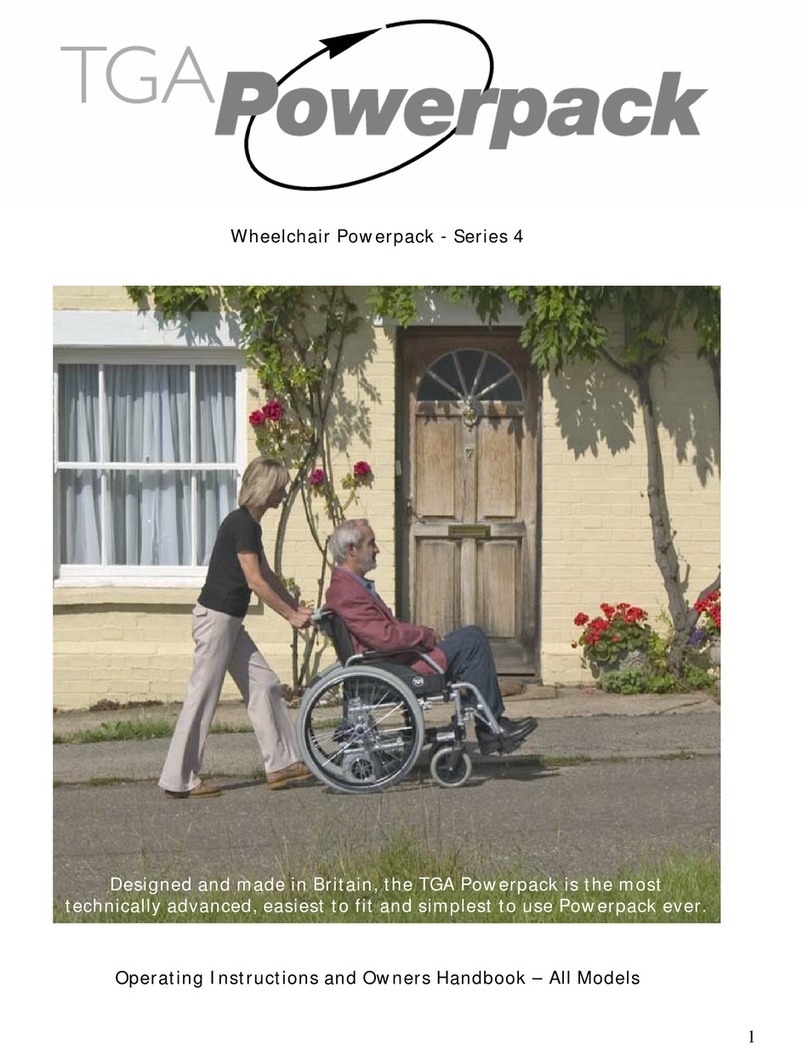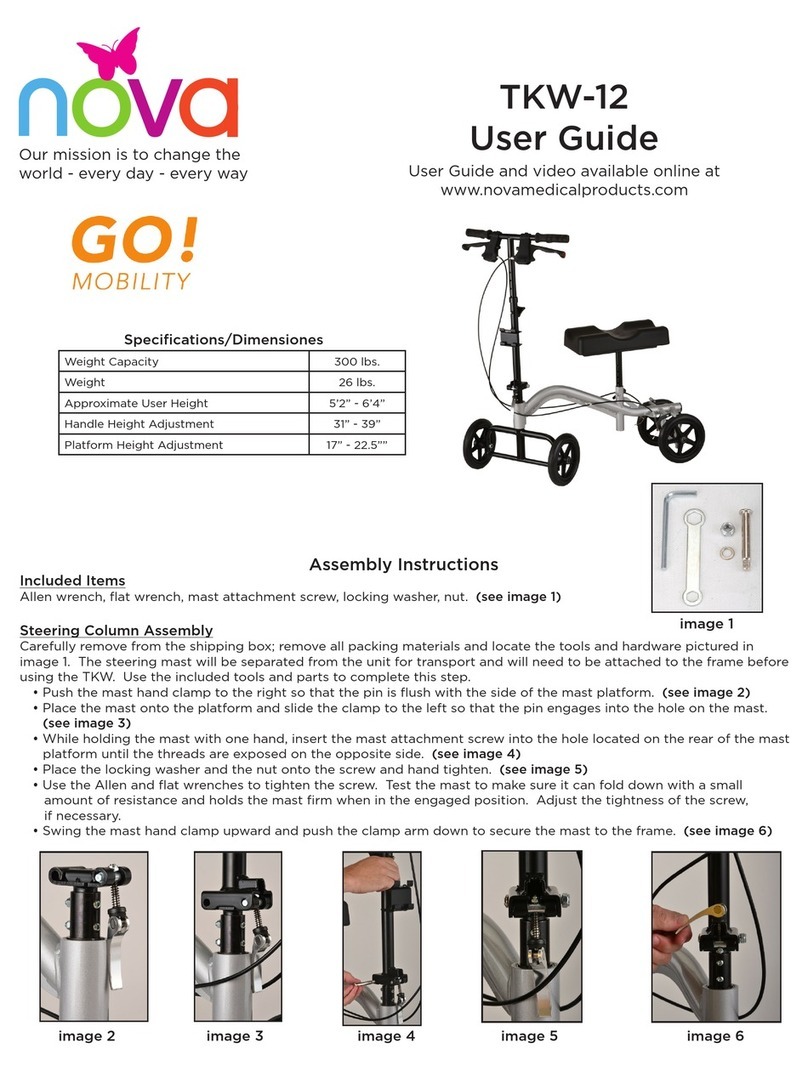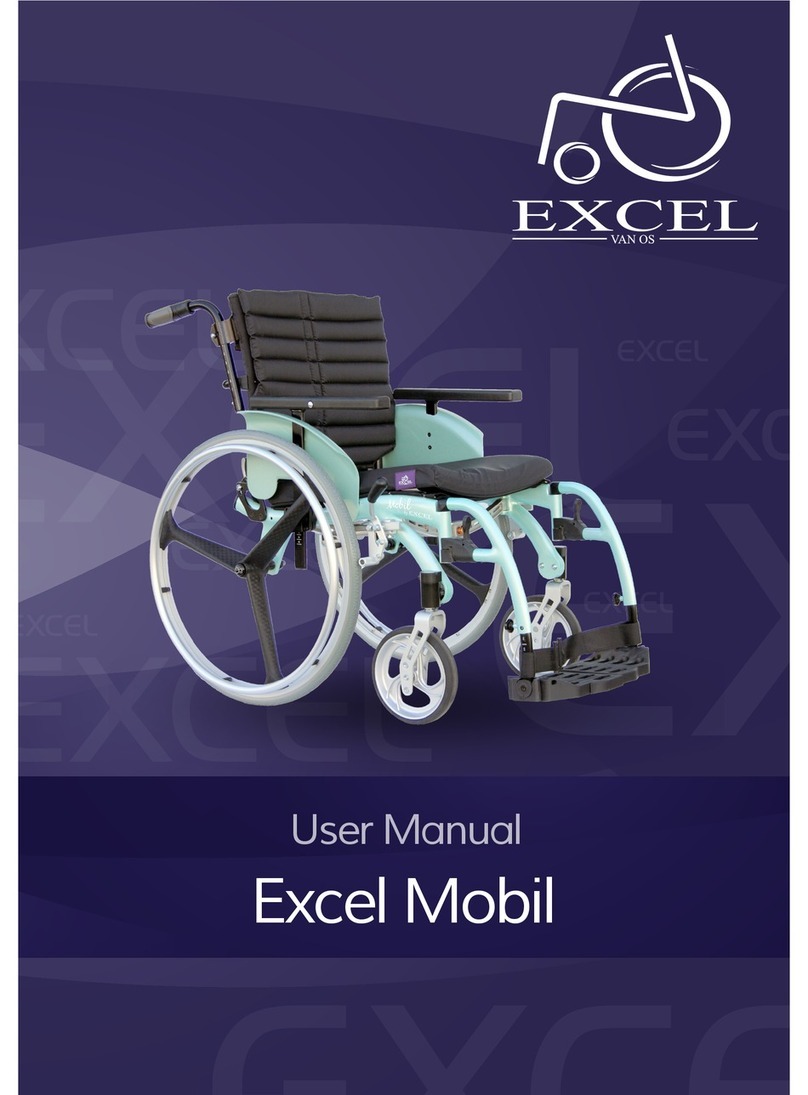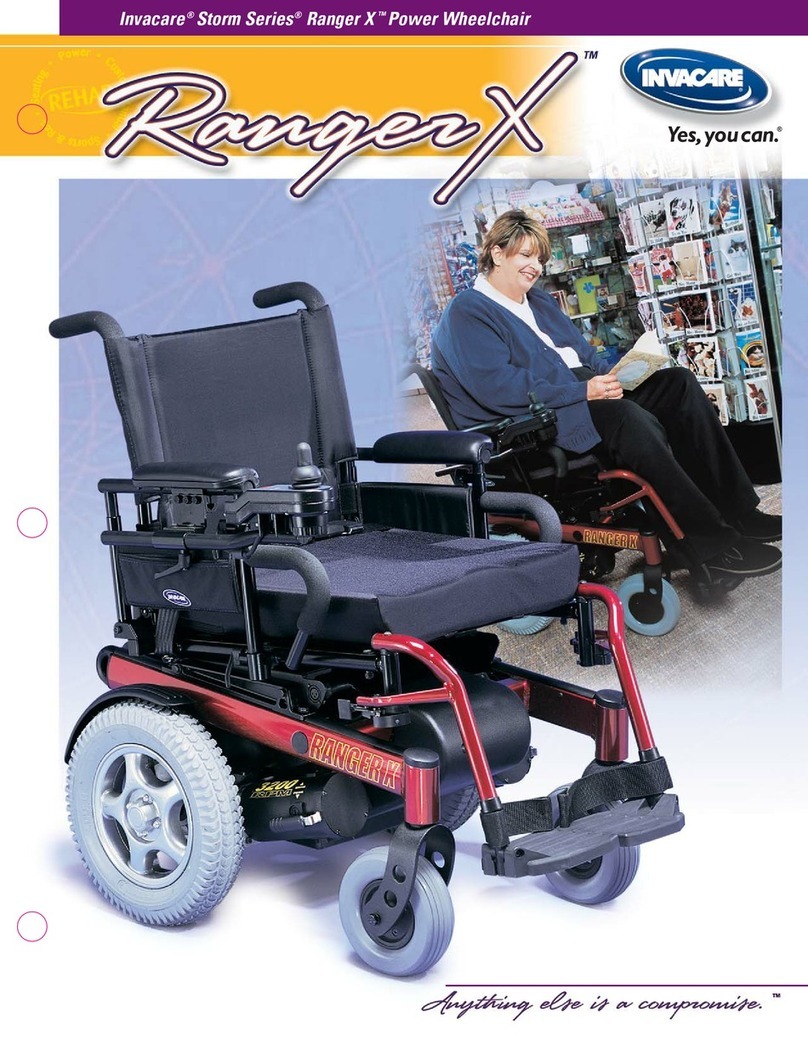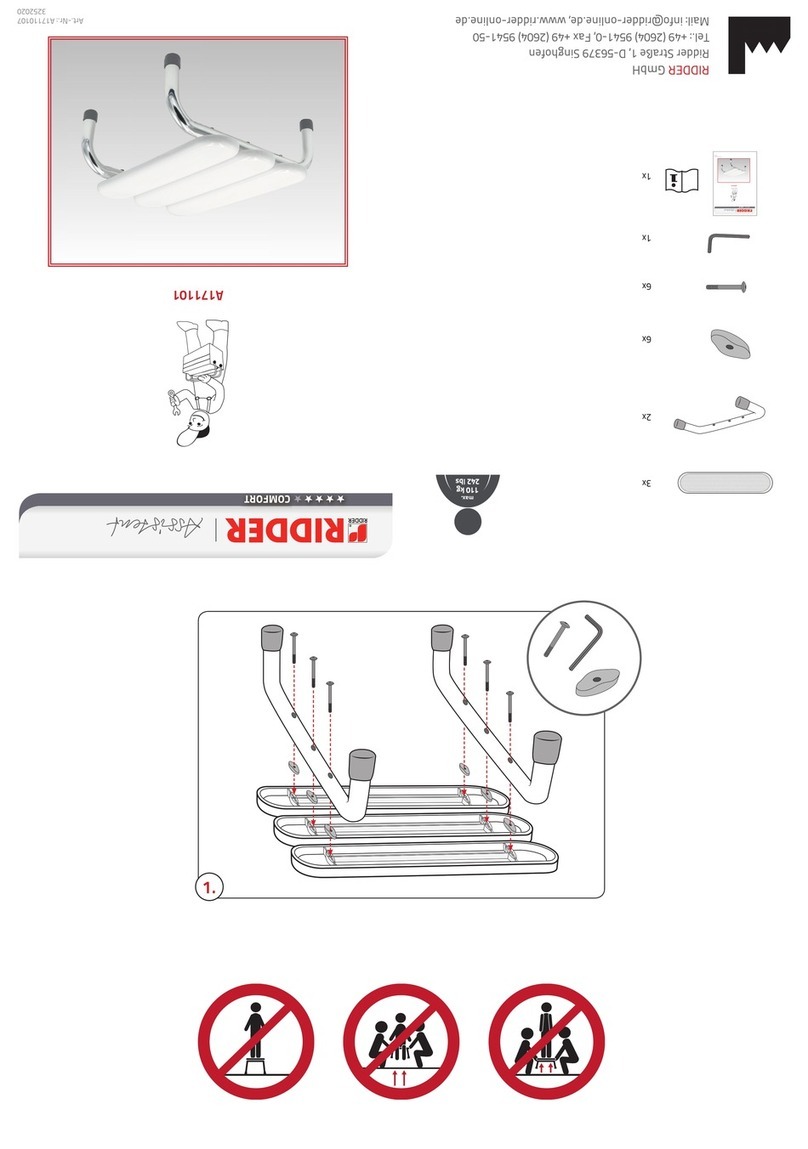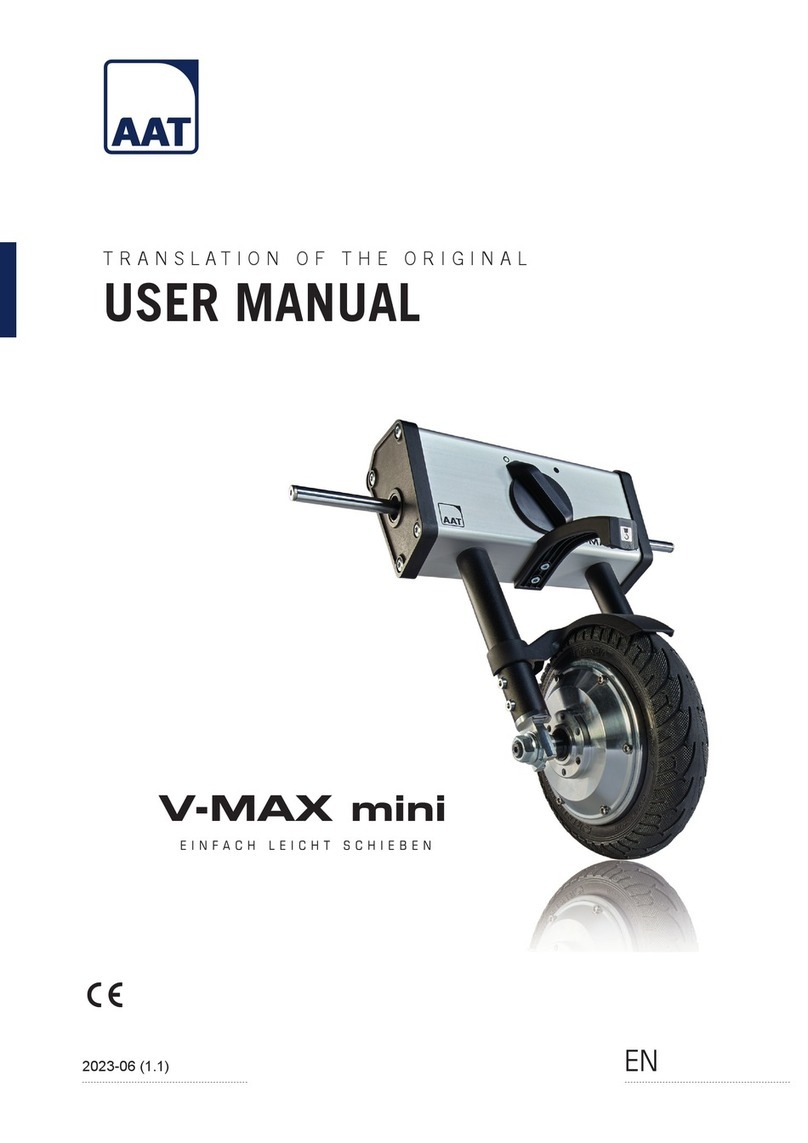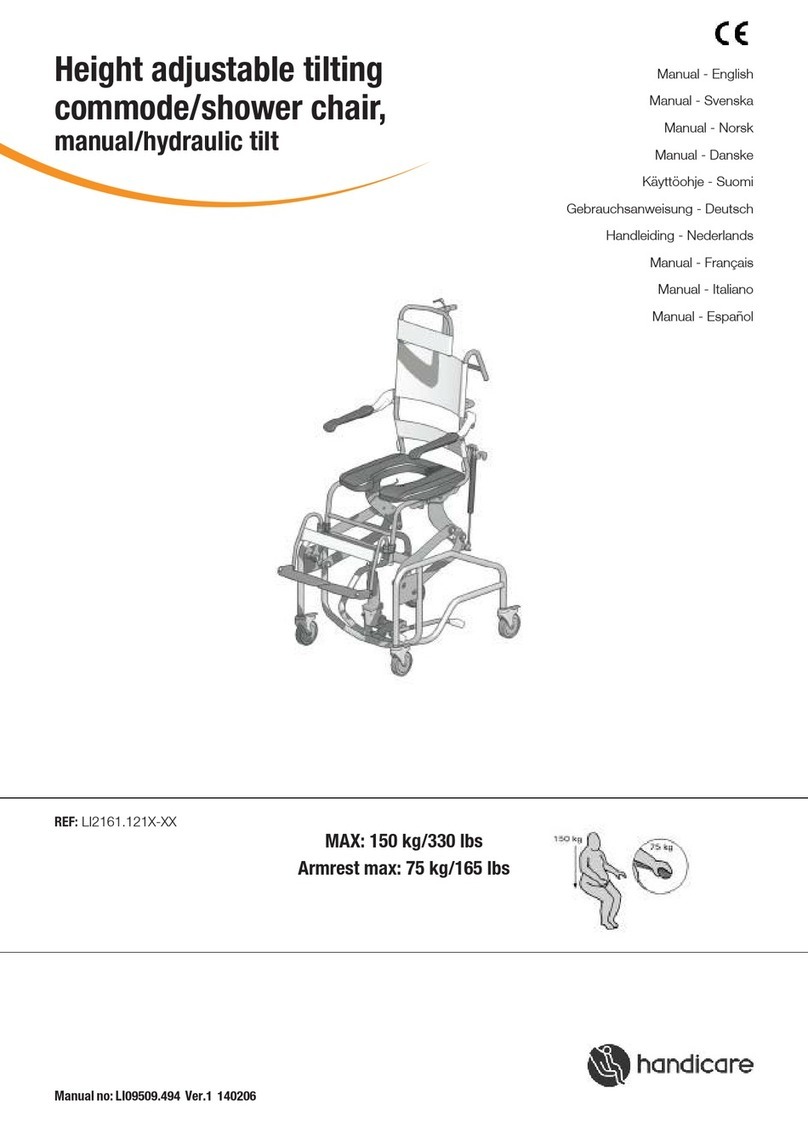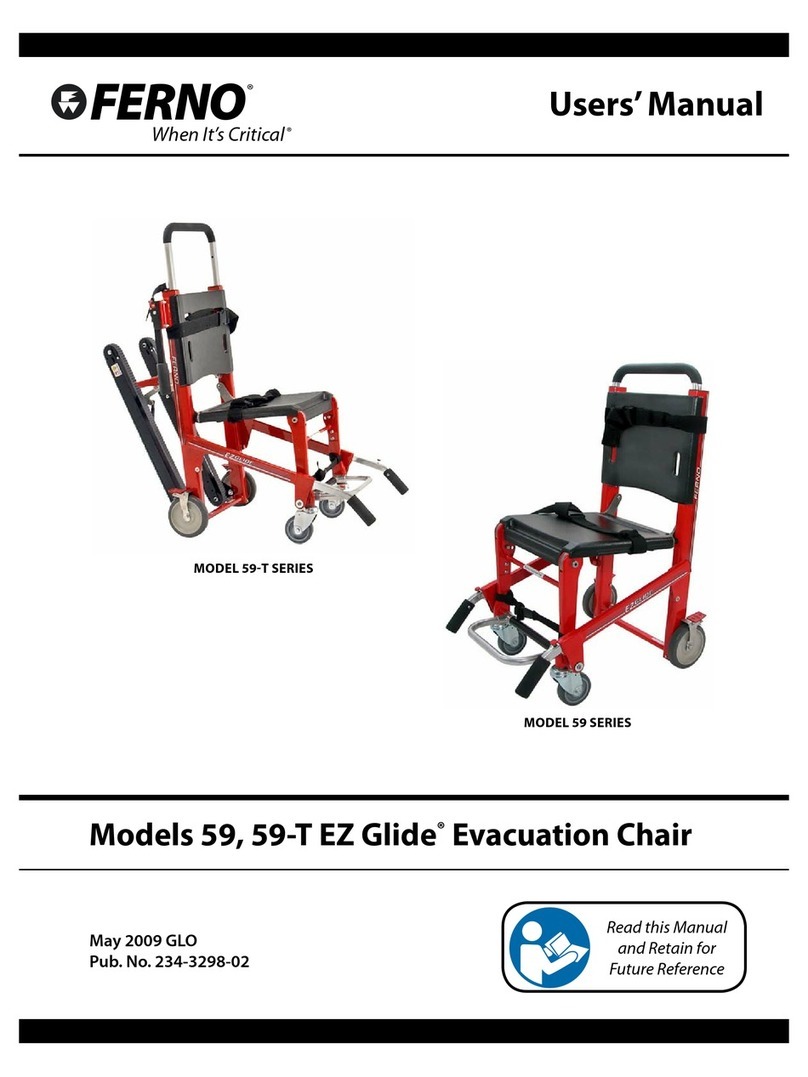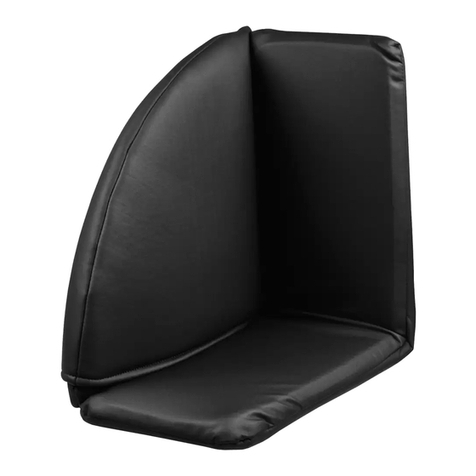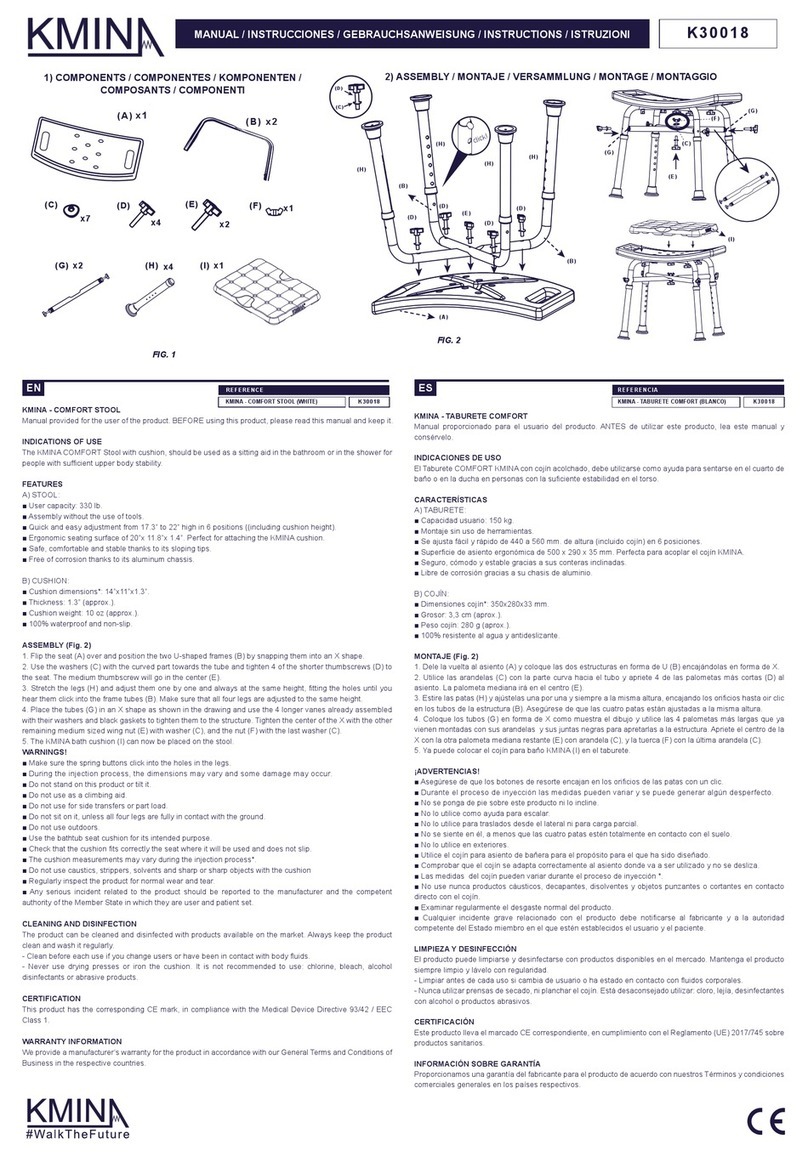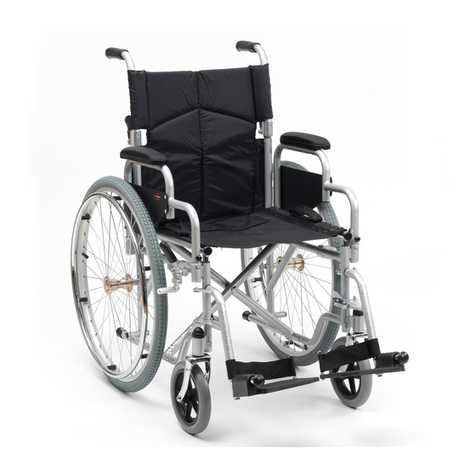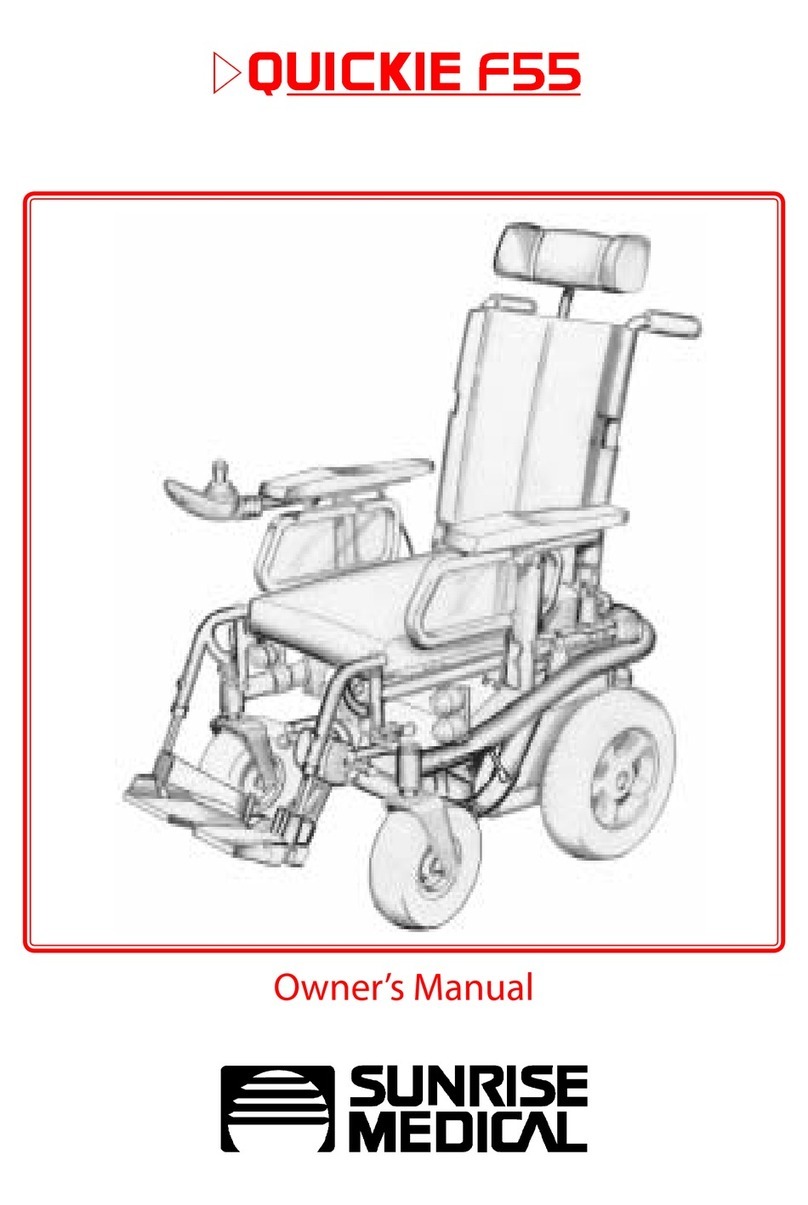TGA Elite Quick start guide

Operating Instructions and Owner’s Handbook

2
CONTENTS
SAFETY SUMMARY Page 3
ASSEMBLY Page 3
USE Pages 3/4
GENERAL DESCRIPTION Pages 4/5/6
ROUTINE CHECKS AND MAINTENANCE Page 6/7
SPECIFICATIONS Page 7

3
Safety Summary
We recommend the following to ensure the safe use of the Elite wheelchair:
Do not assemble or use the product before first reading and understanding this instruction manual. If
there is any information inside this manual that you do not understand then please contact a healthcare
professional or dealership before using this product.
Before first use, care must be taken to ensure all components are secure, the castors and bearings move
freely and that all wheels make equal contact with the ground.
Always observe the limits regarding reaching objects, leaning back, tilting and the use of manual brakes
(see section headed ‘use’).
The foot plates are designed only to support the user’s feet whilst they are seated in the wheelchair,
ensure that you do not stand directly on the foot plates.
The wheelchair is not to be used as a transport seat in a vehicle.
Assembly
1. Remove all contents from the packaging.
2. To open the wheelchair push the seat rails downwards until the wheelchair is fully opened. Note that the
seat rails must be fully engaged in the seat frame support brackets in order to sufficiently support the
user.
3. For the self-propelled Elite wheelchair: To install the rear wheels you must first press and hold the button
on the outside of the wheel’s axle and then slide the axle onto the wheelchair and release the button to
lock the wheel in place.
4. To close the wheelchair, pull the front and back of the seat fabric upwards and the sides of the wheelchair
will now close together.
Use
When using a wheelchair you must often perform certain manoeuvres that alter the balance and weight
distribution of the wheelchair. This wheelchair is designed to be as stable as possible during everyday
usage when used appropriately in accordance with the below recommendations.
1. Reaching/bending forwards: Move the wheelchair as close as possible to the object that you need to
reach, then position the front castors as far forwards as possible. Now fully engage the rear wheel
locks. Remember to only reach out to take what is within arm’s length whilst in the normal seated
position and also ensure that only your arms stretch beyond the seat of the wheelchair.
2. Reaching/bending backwards: We would strictly recommend only to lean or reach backwards if you
have anti-tip wheels/bars installed on your wheelchair, without these in place the wheelchair will be at
risk of tipping. If you have these installed, move the wheelchair as close as possible to the object that
you need to reach then reach backwards only as far as your arms will extend without altering your
seating position.
3. Reaching sideways: Move the wheelchair as close as possible to the object that you need to reach,
engage the rear wheel locks and reach only as far as your arms will allow, do not move your sitting
position closer towards the object you wish to reach as this may alter the stability of the wheelchair.

4
2
10
8
3
9
7
1
5
6
4
4. Transferring: (Ensure that the following is supervised by a certified healthcare professional until the
user and owner are comfortable with the procedure.) Before transferring the user from one wheelchair
to another or another seat, first ensure that the gap between the two seats is as small as possible and
that the wheel locks are fully engaged (this will help to make the transfer as quick and easy as
possible). Also ensure that the foot plates and their support arms are fully folded.
5. Negotiating obstacles:
1. Forwards: The wheelchair should be tilted by the helper until the front castors are higher than the
kerb, move the wheelchair forwards until the rear wheels touch the kerb. Then lower the castors
to the ground and lift the rear wheels up and onto the kerb to follow the castors.
2. Backwards: First bring the wheelchair backwards until the rear wheels touch the kerb, the helper
should then tilt the wheelchair backwards and then pull the wheelchair up onto the kerb. The
castors should only then be lowered once the wheelchair has been pulled clear of the kerb.
3. Inclines and declines: Make sure that the wheelchair goes straight when tackling slopes to avoid
the possibility of the wheelchair overturning.
General Description

5
1. Backrest
The backrest can be folded down to make the wheelchair easier to fit into a vehicle and/or into storage (please see
point number 10 for further instructions).
2. Handles
The handles are designed to assist the helper to propel the wheelchair. They must not be used solely for lifting the
wheelchair over obstacles. Please use both the handles and your feet together when tipping the wheelchair back,
this makes it easier for the helper and puts less stress on the handles.
3. Arm Rest
Padded arm rests are installed as standard for the user’s comfort, the pads are available as spares if at any point
they need replacing.
4. Seat Upholstery
Please ensure that the seat upholstery is regularly inspected for any signs of wear, tearing or sagging and replace
immediately if damaged. Note that the seat upholstery is the main material responsible for supporting the user’s
weight.
5. Footrest Support Arms
These support arms are hinged and can be folded to make the wheelchair easier to fit into a vehicle and/or into
storage. To fold the arms push and hold the black-handled release lever at the top of the arm and then bring the
arm around the sides of the wheelchair. It is then recommended to also fold the foot plates (point number 6) for
easy storage. You can also adjust the height of the foot rests for the user: First remove the nut and bolt keeping
the lower portion of the foot rest in place (the black rod connected to the foot plate with various notches for
different heights), adjust the foot rest to the desired height and then reinstall the nut and bolt to secure the
assembly in place.
6. Foot Plates
The foot plates are intended as a foot support only and designed as such, the user is not to stand or put excessive
weight on the foot plates at any time. There are heel loops installed at the back of each foot rest, these are
designed to help keep the users feet in position and prevent them from sliding from the foot rests during use.
7. Castor Wheels
The front castor wheels are fitted with solid, puncture proof tyres. These should be inspected regularly for uneven
wear, flat spots and signs of splitting. If the castors develop flat spots it can become increasingly difficult to control
and manoeuvre, it is recommended to replace both castors at the same time in order to ensure that the wheelchair
makes even contact with the ground. The castors are connected to the frame of the wheelchair via a castor fork
with bearings allowing the forks to spin freely. It is also recommended to regularly check the torque of the bolts
that secure the forks in place to ensure that they are sufficiently tight, but that the bearings move smoothly and
freely (to access this bolt, remove the protective black cap at the top of the castor fork).
8. Wheel Locks and Brakes
The wheel locks are used to stop both rear wheels and hold the wheelchair in a stationary position. To engage the
wheel locks push both levers either side of the wheelchair forwards towards the front of the chair until they click
into place, to disengage them pull the levers towards the back of the chair. The wheel locks must not be used as a

6
method of braking whilst the wheelchair is in motion; the brakes are applied by the helper via the brake levers
attached to each handle of the wheelchair.
9. Cross Brace Section
The purpose of the cross brace section is to enable the wheelchair to collapse easily for storage whilst maintaining
rigidity when laden. The cross brace section should be checked regularly for signs of damage such as warping of
the metal supports or excessive movement.
10. Backrest Folding Mechanism
The top portion of the backrest including the handles can be folded down to make the wheelchair easier to fit into
a vehicle and/or into storage. To do this, first pull the small black-handled plungers outwards (point 10 of the
diagram) and then pull the handles downwards. When it comes to bringing the handles back upwards they simply
click into place at their full extension.
Routine Checks and Maintenance
Upholstery
Upholstery should be cleaned regularly with a mild soap and water solution, avoid any chemicals that are abrasive
or corrosive that could adversely affect the strength of the material.
Metal Parts
Clean any metal parts with a wax solution like car wax, avoid any obtrusive products that will scratch the paint
finish.
Cross Brace
Periodically lubricate the center bolt on the cross brace with light machine oil if it is not moving smoothly.
Rear Wheels
On the self-propelled model examine pneumatic tyres regularly to ensure that there is sufficient tread depth, that
they are running at the correct pressures and that there are no cracks appearing. On the transit model check the
solid tyres for flat spots, uneven wear and signs of the tyre separating from the rim. Ensure that solid tyres are
replaced in pairs to ensure that the Wheelchair maintains even contact with the ground. Check also that the
wheels are turning smoothly and that the quick-release axles are securely locked in place.
Castors
Same as the above. Check for flat spots, uneven wear and signs of the tyre separating from the rim. Ensure that
solid tyres are replaced in pairs to ensure that the Wheelchair maintains even contact with the ground. Also
periodically check the castor axle tightness ensuring that they are tight but still allow the castor wheels to spin
freely and smoothly.
Brakes/Wheel Locks
Inspect the wheel locks to ensure that they engage fully and do not allow the chair to move. If the brakes are stiff
and offer more resistance than usual you can use a fine lubricant such as Teflon spray to coat the brake cable
allowing it to move more freely within the cable sleeve.

7
General
Always check before use that the chair folds and unfolds with ease and that the movement both forwards and
backwards is in a straight motion.
Servicing
We recommend that the wheelchair be serviced annually. If you require any spare parts or service information
please contact our service department on 01787-888-100.
Specifications
Transit
Specification
Detail
Metric
Imperial
Maximum User Weight
115kg
18 stone
Wheelchair Weight
12.5kg
27.5lbs
Seat Width
410 / 460mm
16inches / 18inches
Seat Depth
430mm
17inches
Back Height
460mm
18inches
Overall Height
Back in upright position
920mm
36inches
Self-Propelled
Specification
Detail
Metric
Imperial
Maximum User Weight
115kg
18 stone
Wheelchair Weight
With Wheels
15kg
33lbs
Wheelchair Weight
Without Wheels
11kg
24lbs
Seat Width
410 / 460mm
16inches / 18inches
Seat Depth
430mm
17inches
Back Height
460mm
18inches
Overall Height
920mm
36inches

8
TGA Electric Leisure Ltd ● Woodhall Business Park ● Sudbury ● Suffolk ● CO10 1WH
T 01787 882244 ● F 01787 882248
www.tgamobility.co.uk
TGA Electric Leisure Ltd reserves the right to change specification and/or prices without prior notification or warning
INS14v1
Table of contents
Other TGA Wheelchair manuals
